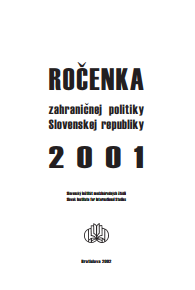Vystúpenie Juraja Šveca, podpredsedu Zahraničného výboru Národnej rady SR
Presentation of the Vice-Chairman of the Foreign Affairs Committee of the National Council of the Slovak Republic Juraj Švec
Author(s): Juraj Švec
Subject(s): Politics, Law, Constitution, Jurisprudence, Human Rights and Humanitarian Law, Government/Political systems, International relations/trade, Security and defense, EU-Approach / EU-Accession / EU-Development, EU-Legislation
Published by: Research Center of the Slovak Foreign Policy Association (RC SFPA)
Keywords: Slovakia; 2001; foreign policy; Vice-Chairman of the Foreign Affairs Committee; Juraj Švec; presentation; parliament; human rights; EU; integration; legislation; NATO;
Summary/Abstract: The 10-year-long endeavour of the Central European countries focused on reconstruction of their political and economic system found its reflection in strengthening and consolidation of democracy and thus in achieving a considerable level of integration capacities, necessary for a successful finish of the integration process. On the other hand the integration configuration of the EU states as a recipient of new democracies needed a whole decade to reach an appropriate absorption capacity that would enable the EU to enlarge by 5 up to 10 new member states. The EU Summit in Nice in December 2001 became despite many doubts and disbeliefs the crucial breaking moment of the EU enlargement process. It defined the necessity of institutional changes in the structure of the EU because of the enlargement process and called upon the representatives of the national parliaments and political, economic and university circles to open a wide discussion about the political and economic organization of our continent. The Nice Summit co-invited the candidate countries to participate in a preparation of the reform in following four directions: - division of organization between the EU institutions and institutions of the member states; - implementation of the EU Charter of Human Rights; - issue of simplifying resolutions of the EU Summits to make them more understandable for a wider European public; - role of national parliaments in creating the architecture of future Europe.
Book: Ročenka zahraničnej politiky Slovenskej republiky 2001
- Page Range: 29-32
- Page Count: 4
- Publication Year: 2002
- Language: Slovak
- Content File-PDF

